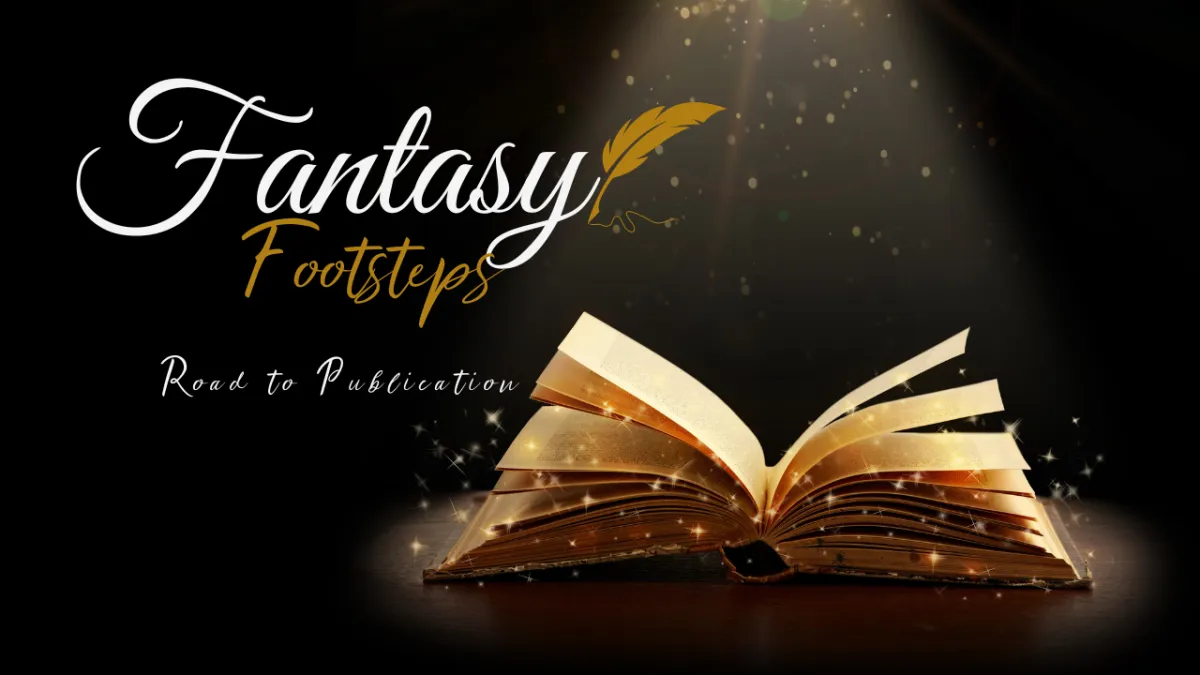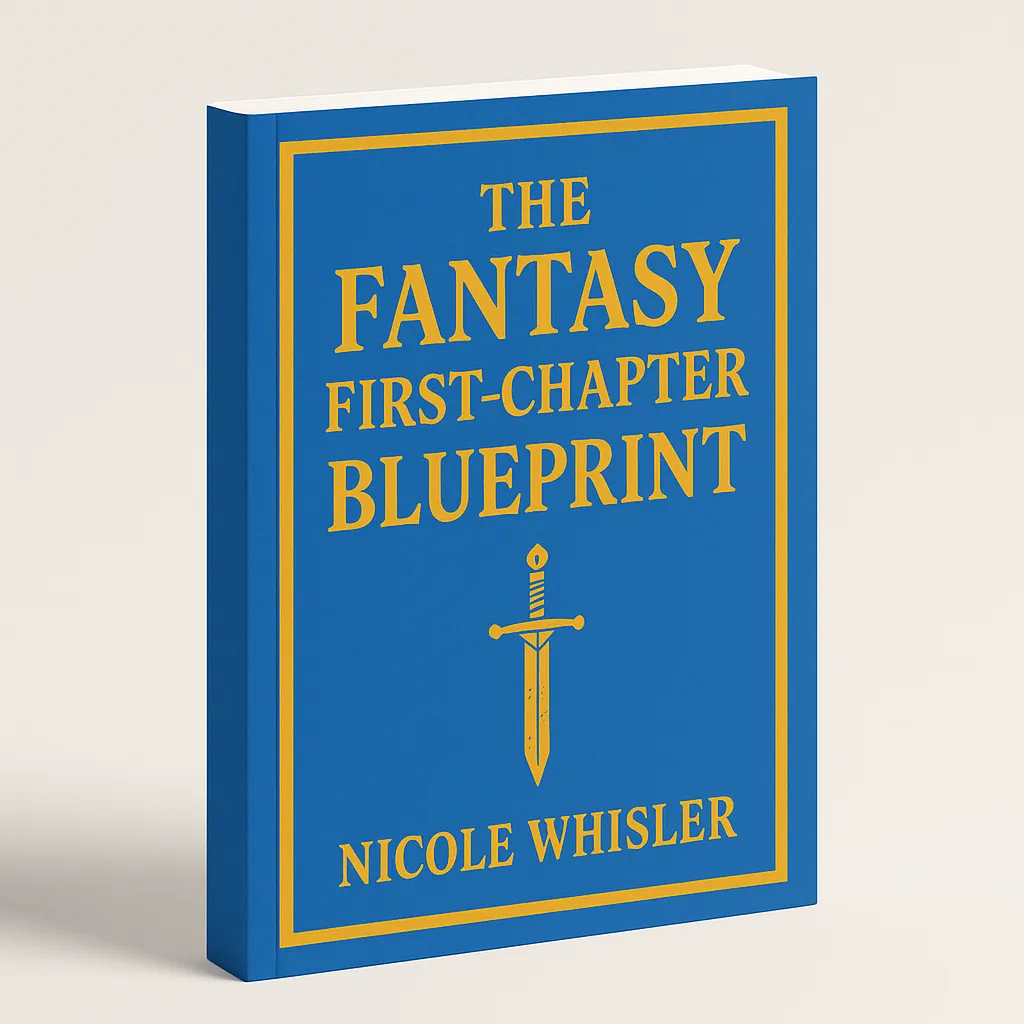The Fantasy First-Chapter Blueprint
Your first chapter is your one shot to hook an agent or a reader. Don't let the 7 deadliest mistakes land your manuscript in the rejection pile. This free 7-day email course gives you the step-by-step blueprint to avoid them and craft an irresistible opening.

Your Novel Matters ...
Looking for the right book coach for your fantasy novel?
Are you a fantasy writer …
… struggling to convert the vivid scenes of your fantasy novel from your imagination to the page?
… stuck in a loop where you constantly rewrite your opening pages?
… worried your story won’t resonate with your readers?
What if I could show you the exact steps week to week that would take you from brainstorming and drafting to revising and publication?
I specialize in developmental editing and book coaching for writers of fantasy novels—writers who value the craft of storytelling and wish to create stories that resonate.
My Services
Develop Your Ideas
Fantasy Footsteps: Road to Publication

I’ll let you in on a secret. All you need to succeed as a writer are three things:
A Roadmap: Illuminate your path with a step-by-step guide, ensuring you achieve your writing goals every week. From outlining to publishing, every stage of your journey is mapped out for success.
Mindset Mastery: Learn how your thoughts control your outcomes in your writing. Overcome self-doubt and unearth the confidence that will bring your unique ideas to life on the page.
Personalized Support: Prepare for comprehensive assistance, real-time accountability, and feedback tailored to your needs. From brainstorming sessions to final publication, you'll have a dedicated ally guiding you every step of the way.
With these three pillars, you'll unlock the potential to:
Craft a captivating story that enthralls readers from the first page to the last.
Develop complex characters and immersive worlds that resonate deeply with your audience.
Navigate the complexities of plot twists and pacing, keeping readers hooked until the final chapter.
Receive specific guidance on refining your scenes so that readers root for your protagonist.
Overcome writer's block and stay motivated throughout your writing journey, ensuring consistent progress.
Transform your rough draft into a polished, professional manuscript ready for publication.
Are you ready to turn your fantasy novel from a mere vision into a masterpiece that captures hearts and minds?
Join Fantasy Footsteps: Road to Publication and begin your author journey with everything you need to write a story that works.
Don't let your story remain trapped in your mind—bring it to life with me!
If you’re thinking, “Yes, please! Tell me what to do!” , I’d like to invite you to work one-to-one with me to finish your novel and write a story that works. Join my book coaching program designed specifically for fantasy writers—Fantasy Footsteps: Road to Publication.

Discover Helpful Tools
Resources For Writers
Here you will find some of my favorite resources for writers.
Add these books, podcasts, websites, and other resources to your writing toolbox to augment your writing at any stage.
Join My Free, Private Facebook Group
Finish My Fantasy Novel: Write & Revise My Best Book in 6 Months
In the group, I go live weekly with writing tips. The group is also a platform for writers to support each other and share their wins and progress.
Live training schedule:
1st Tuesday of the month: Free critique for someone in the group!
2nd Tuesday of the month: Writing sprint with fellow writers
3rd Tuesday of the month: Live training on a specific topic
4th Tuesday of the month: Interview with an author or marketing/business expert


Improve Your Craft
Writing Advice Blog
As a developmental editor and book coach, everything I post is designed to help you build your creativity, strengthen your prose, and explore new avenues in your writing. The opinions in each post are my own, but many are inspired by ideas from established authors and editors who excel in their fields.
Rely on my blog for clear and specific writing advice, motivational tips and grammatical aid, and interviews with experts!
Hi! I'm Nicole.
I’m a Developmental
Editor & Book Coach for Fantasy Writers.
Like you, I'm a writer. I understand the mental and emotional ups and downs of storytelling. Don't let resistance win! Recognize the value of good advice plus hard work.
My approach to novel writing is multifaceted. For a deeper understanding of my process and style, take a look at some of my favorite craft-of-writing books in my Resources section.
What can I say about myself? I read, I write, I read about writing, and I write about reading. It never gets old to me.

See what writers like you are saying . . .

Nadir Shirazi
“I’ve been stalling on my Islam-inspired sci-fantasy series for 10 years. But within 10 minutes of starting Nicole’s program, I started writing again."

Amanda Emerick
“I can’t recommend Fantasy Footsteps enough to writers who are legitimately looking to polish their craft, write, and eventually publish their novel."

Trinity Cunningham
“I loved discussing my story with Nicole. She provided me with invaluable insights I never would have considered on my own."
Latest on the Blog

You will find no pictures of kittens here. No images of favorite dessert recipes, snapshots of my recent vacations, videos of puppies playing the piano (although I do love dogs), or YouTube clips of monkeys stealing people’s sunglasses.
I’m genuinely sorry if that disappoints you.
Instead, you can rely on my blog for clear and specific writing advice, motivational tips, grammatical aid, and author/editor interviews.
As a developmental editor & book coach, everything I post is designed to help you build your creativity, strengthen your prose, and explore new avenues in your writing. The opinions in each post are my own, but many are inspired by ideas from established authors and editors who excel in their fields.
Some of these tips might be just what you need to hear. Others might not work for you personally, and that’s okay.
Apply the tips that fit your personality and writing habits, and feel free to adapt or ignore the others. For further questions and comments, you can email me or reach me through my Contact page.

5 Modes of Storytelling: How to Balance Dialogue, Action, & Worldbuilding
Discover in this post …
five items to include in your story to immerse readers.
an excerpt from The Name of the Wind that uses all five items.
explanations to help you apply these narrative techniques to your own story.
Same Story, Different Narration
A writer came to me the other day worried about the amount of dialogue she had written in her fantasy draft.
“How much is too much?” she wanted to know. “Is there a formula?”
To which I replied, “Your dialogue should take up exactly 20% of your manuscript. Any more is too much, and anything under is too little. Remove words until your dialogue fits this percentage.”
Just kidding. I did not say that. (Nor do I believe this, to be clear.)
But I knew exactly where this writer was coming from. Where so many writers are coming from.

They want to know if their manuscript appears balanced. If readers will immerse themselves in the story, or if the emphasis on dialogue (or some other aspect) will be distracting or slow the pacing.
It’s a fair concern. So I thought I would dedicate this post to that writer today—and to anyone else who’s wondering if their story will read smoothly to readers.
To explore this topic, we need to know what our options are.
Because we can tell stories in different ways, can’t we? We can sit around a campfire and say …
It was a rainy, spooky night. Lenny and Ralph stumbled upon a ghost in the forest, a ghost that chased them for miles, demanding they give up their souls to become ghosts themselves.
The story moves along quickly with this example, doesn’t it? Readers immediately have a grasp of what’s happening in this story. We’re waiting to get more details, of course—we don’t have a strong idea of why we should care about these characters yet, for example—but we’re willing to keep listening to see where the story is headed.
Or we can sit around that same campfire and tell that same story in a different way:
Rain streamed from the night sky, soaking Lenny down to his boots. Every step squelched as he plodded along. He could see no more than an arm’s length in front of him. Was their cabin close? For Ralph’s sake, he hoped so. From behind, Ralph’s small fingers grasped Lenny’s jacket.
Ralph shouted something, but Lenny couldn’t hear him in the downpour.
Don’t let me go, he imagined Ralph saying, I’m only little.
And Lenny wouldn’t. He wouldn’t move a muscle unless he was certain his brother was with him. Not like last year, when he’d lost sight of Ralph for a terrifying ten minutes at the county fair.…
Something glowed through the rain ahead. Lenny squinted. What was that? He moved forward, and a sour taste filled his mouth. Whatever was blocking the forest ahead of them had a shape to it, a substance. Too large to be a flashlight—and no one knew they were out here to begin with. No one was looking for them.
The glowing figure moaned and shifted, swaying a few steps ahead of them, blocking their path. Lenny stopped, and Ralph collided with his legs.
“Wait, Ralph,” Lenny muttered, frozen, knowing his brother couldn’t hear him. That was all right because he didn't have any words to comfort him.
After all, he’d never encountered a ghost before.
See? Two ways to convey the same story. While you can tell stories any way you like, you might have noticed that the second version has more depth to it, more opportunity for character connection.
This is because it contains multiple modes of storytelling. It doesn’t remain “flat” as the first story does.
Telling a moderately “flat” story can certainly work around a campfire or when describing an incident in your day. But the most compelling stories include a variety of layers.
But what are those layers? In essence, we have five items to work with:
Dialogue
Description
Exposition
Internal thought
Action
Let’s dissect each below so that you can use these items in your own writing to draw readers in and make them want to stay.
Balancing the Modes of Storytelling
To demonstrate how to balance the modes of storytelling I’m about to define, I’ve included an excerpt from one of my favorite novels, The Name of the Wind by Patrick Rothfuss. Read through it, and we’ll examine its components together. I’ll explain the colors after the excerpt.
For context, the main character, Kvothe, doesn’t have a penny to his name in this passage. He has just negotiated with an innkeeper and taken a bath, and now he finds himself in desperate need of new clothes:
As I rinsed myself for the last time, I looked at my discarded clothes. Cleaner than I’d been in years, I didn’t want to touch them, let alone wear them. If I tried to wash them they’d simply fall apart.
I dried myself off and I used the rough brush to pull through the snarls in my hair. It was longer than it had seemed when it was dirty. I wiped the fog from the makeshift mirror and was surprised. I looked old, older at any rate. Not only that, I looked like some young noble’s son. My face was lean and fair. My hair needed a bit of a trim, but was shoulder-length and straight, as was the current fashion. The only thing missing was a noble’s clothes.
And that gave me an idea.
Still naked, I wrapped myself in a towel and left by the back door. I took my purse but kept it out of sight. It was a little before noon and people were everywhere. Needless to say, quite a few eyes were turned in my direction. I ignored them and set a brisk pace, not trying to hide. I composed my features into an impassive, angry mask without a trace of embarrassment.
I stopped by a father and son loading burlap sacks into a cart. The son was about four years older than me and head and shoulders taller. “Boy,” I snapped. “Where can I buy some clothes around here?” I looked pointedly at his shirt. “Decent clothes,” I amended.
He looked at me, his expression somewhere between confusion and anger. His father hurriedly took off his hat and stepped in front of his son. “Your lordship might try Bentley’s. It’s plain stuff, but it’s only a street or two away.”
I darkened my expression. “Is it the only place about?”
He gaped. “Well … it could … there’s one …”
I waved him impatiently into silence. “Where is it? Simply point, since your wits have left you.”
He pointed and I strode off. As I walked I remembered one of the young page parts I used to play in the troupe. The page’s name was Dunstey, an insufferably petulant little boy with an important father. He was perfect. I gave my head an imperious tilt, set my shoulders a little differently and made a couple of mental adjustments.
I threw open the door and stormed in. There was a man in a leather apron who I can only assume was Bentley. He was fortyish, thin, and balding. He jumped at the sound of his door banging against the wall. He turned to look at me, his expression incredulous.
“Fetch me a robe, lack-wit. I’m sick of being gawked at by you and every other mewler that decided to go marketing today.” I slouched into a chair and sulked. When he didn’t move I glared at him. “Did I stutter? Are my needs perhaps inobvious?” I tugged at the edge of my towel to demonstrate.
He stood there, gaping.
I lowered my voice menacingly. “If you don’t bring me something to wear—” I stood up and shouted, “—I’ll tear this place apart! I’ll ask my father for your stones as a midwinter gift. I’ll have his dogs mount your dead corpse. DO YOU HAVE ANY IDEA WHO I AM?”
Fun passage, isn’t it? Let’s explore how Rothfuss used each of the five modes to great effect.
Dialogue (Underlined)
Dialogue refers to spoken conversation between characters. I’ve underlined all the dialogue in the excerpt above.

You can see that although there’s plenty of dialogue in this passage, it’s surrounded by a great deal of other context. It’s possible to write an excellent scene—or even a full short story—where the dialogue nearly stands alone, but in a passage where you’re trying to create more depth, it’s more than what’s said that matters. It’s the subtext (the meaning that lies underneath the words) that carries the most weight.
In the passage above, we like knowing what Kvothe is saying, but it’s even more important for us to understand why he’s saying it. He wants people to believe he’s a noble’s son, so he consciously chooses words and mannerisms that match that impression.
The takeaway:
Help readers get to know your characters through both their speech and the true meaning that lies beneath their words.
Description (In Green)
Describing your setting, characters, and surroundings gives readers a clear mental picture of where they are in the scene. If readers don’t know how to picture the environment, you might be guilty of “white room syndrome” (see my blog post on how to avoid this issue), where your characters seem to be floating in a hazy white space during their conversation because readers don’t know where they are.
I’ve put a few examples of Rothfuss’s descriptions in green. Notice that each detail is included for a reason. Kvothe describes his own appearance because it triggers the realization that he could pass for a noble. Rothfuss includes Kvothe’s description of the son loading burlap sacks into a cart as “about four years older than me and head and shoulders taller” to heighten the impact and absurdity that Kvothe should successfully talk down to such a person.
The takeaway:
Check that you’ve provided enough visual and sensory details to help readers ground themselves in your scene’s setting, and don’t miss out on the opportunity to make each detail relevant.
Exposition (In Blue)
In the passage above, I’ve identified an instance of exposition in blue. Here it is so you don’t have to scroll back up:
As I walked I remembered one of the young page parts I used to play in the troupe. The page’s name was Dunstey, an insufferably petulant little boy with an important father.
Exposition refers to background information that helps readers gain an understanding of the story’s present events and gather deeper meaning from them. In the excerpt above, Kvothe adopts the attitude of an insufferable character he once played. Including this relevant detail helps readers make sense of Kvothe’s ability to change his demeanor and behavior so effectively—because Kvothe has played this part before.
The takeaway:
Keep your exposition short and relevant. If readers can’t identify why the character is suddenly recalling expository details, necessary exposition turns into info-dumping.
Internal Thought (In Purple)

Internal thought can be direct (How can he be so stubborn?) or indirect (He’d always been stubborn, that one). Direct thoughts are typically italicized, as in my made-up example in the previous sentence, while indirect thoughts (also known as “free indirect discourse”) are simply part of the character’s view of the world. We don’t need to separate them from the story through italics because we’re already in the point-of-view character’s head.
Rothfuss gives us some of Kvothe’s thoughts using indirect internal thoughts in the excerpt. I’ve included a few examples in purple, and here’s one of them:
Cleaner than I’d been in years, I didn’t want to touch them, let alone wear them. If I tried to wash them they’d simply fall apart.
These are Kvothe’s thoughts, but again, we don’t need to italicize them. We’re already reading the story from Kvothe’s perspective, so we’re directly in his point of view. Including these lines helps us understand what Kvothe is thinking—that his clothes are a poor match for his clean self—and gives us an opportunity to attach to him. If we never knew what he was thinking, and we relied on his dialogue and actions alone, we’d be one step removed from his inner person. We wouldn’t feel as close to him as we do.
The takeaway:
Help readers attach emotionally by including glimpses of your point-of-view character’s internal world. The more we understand your character’s reasoning and inner struggles, the more we root for them.
Action (In Red)
I’ve included many examples of action in red toward the beginning of the excerpt. Action is what you think it is: something is happening. Characters are doing something, whether it’s the protagonist or someone else.
If characters speak and think, and readers have a solid grasp of the environment, but nothing happens on the page—that is, no one acts in a way that moves the story forward—readers will notice. And they probably won’t like it.
Not only should your characters act, but their actions should also be memorable for readers if you want to create a powerful story. Consider the actions Kvothe takes in the passage:
He walks out into the street naked, wrapped only in a towel.
He composes his features into an impassive, angry mask.
He waves someone older and taller than him into silence.
He throws open the door to a shop and storms in.
He controls his voice to serve his purpose and convince others around him that he’s a noble.
The takeaway:
Mild actions aren’t as memorable as direct and humorous ones. Keep this in mind as you’re crafting your story.
Summing Up
It takes a balance of all five modes of storytelling to convey a powerful story, but remember that “balance” doesn’t mean you need to split everything evenly into percentages. If you’re worried your story is unbalanced and losing its impact, choose a passage and identify the modes you’ve already included (much as I’ve done above). If one of the modes is missing, that should tell you something. If one of the modes is overly prevalent, note that as well.

Ask yourself questions like …
“What’s the effect of including so much internal thought here? Will it slow my story down, or will it help readers connect?”
“What purpose does this exposition serve? Do readers need to know this now, or is there a more natural place for it? Is there a realistic reason my point-of-view character would be thinking of this information at this moment?”
If in doubt, pass your draft along to a critique partner or trusted reader. They’ll likely have some feedback for you that will help you craft a stronger story.
And if you’d like some practice before turning to your own pages, go back to my story about Lenny and Ralph at the beginning of this post. I’ve included all five modes in the lengthier version of the story—can you locate them?
How balanced and immersive is your story? Do you use the five modes of storytelling throughout? Do you have a favorite mode and a least favorite? I’d love for you to email me at [email protected] and let me know!
Do you want to learn how to write a story that makes your target readers stand up and cheer? If you’d like support from A to Z (from brainstorming to drafting to revising to publication), book a Discovery Call with me to see if you’re a good fit to join my book coaching program, Fantasy Footsteps: Road to Publication. And if you haven’t done so already, grab your Free Guide on how to hook readers from your story’s start!

Capture Your Readers from Your First Scene
Get my exclusive blueprint—7 Mistakes to Avoid in Your Fantasy Novel’s Opening. Start your fantasy novel right!
Are you worried you've failed to establish a bond between readers and characters in your first chapter? Do you wonder if you've bogged readers down with your worldbuilding? Do you sometimes overlook essential conflicts? Many readers will put your book down if it doesn't grab their attention right away, so it's vital to evoke powerful emotions from readers as early as possible.
Don't let these common mistakes rob your story of its magic and momentum. Save your precious time and energy by ensuring you hook readers from the start. Grab your guide now and check your opening against these common missteps!
(You will also receive monthly writing advice, updates about my free live trainings, and direct access to replays. Unsubscribe anytime.)


